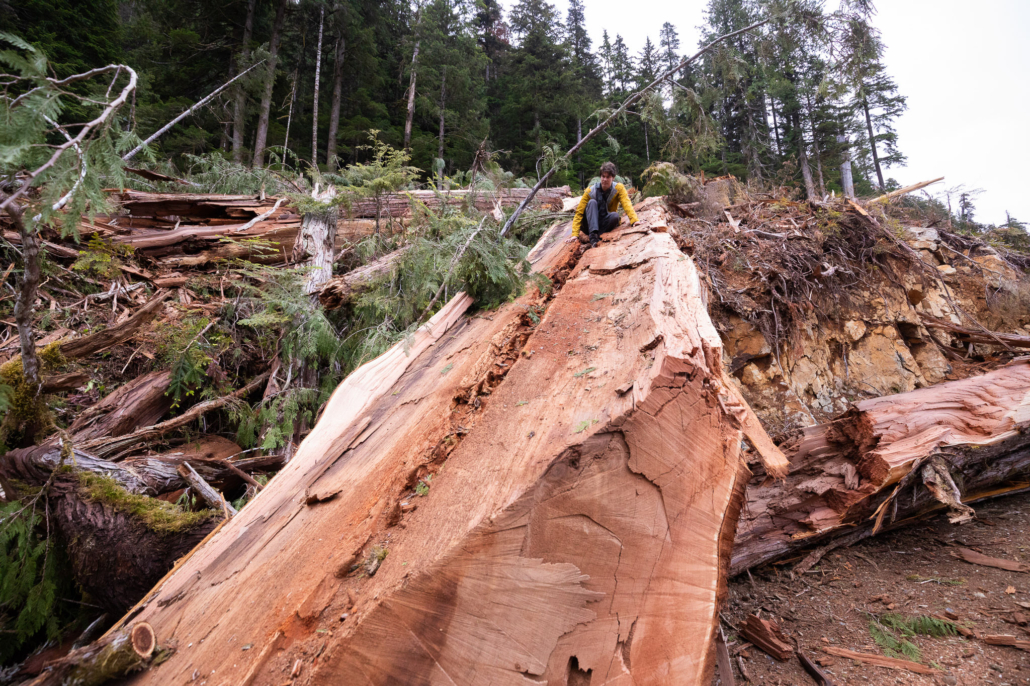 Jul 2 2024
Jul 2 2024Massive Old-Growth Trees Cut in the Nahmint Valley via BC Timber Sales
For Immediate Release
July 2, 2024
Massive Old-Growth Trees Cut on Vancouver Island in the Spectacular Nahmint Valley, planned and approved by the BC Government’s Own Logging Agency
Shocking photos and drone footage reveal “old-growth carnage” as trees upwards of 9 feet (3 meters) wide and more than five hundred years old are logged under the management of BC Timber Sales in the famed Nahmint Valley on Vancouver Island, BC. Conservationists are urging the BC government to immediately identify substantial tracts of misidentified at-risk old-growth forests that should be eligible for logging deferrals that may have been missed due to data errors, to provide deferral funding or “solutions space” funding to First Nations to facilitate the protection of these stands, and to implement “ecosystem-based” protection targets. A species at risk, oldgrowth specklebelly lichen, was also documented in the now logged area, potentially for the first time in the Nahmint Valley.
Conservationists with the Ancient Forest Alliance (AFA) have documented the clearcutting of a superlative ancient forest in the Nahmint Valley near Port Alberni in the territory of the Hupačasath, Tseshaht, and Yuułuʔiłʔatḥ First Nations. The clearcut spans 17.4 hectares or roughly 31 football fields and contains scores of giant old-growth trees, including monumental redcedars and rare, old-growth Douglas-fir trees. The cutblock was home to oldgrowth specklebelly lichen, a species at risk found only in old-growth forests, as well as being mapped as suitable habitat for the endangered marbled murrelet. BC Timber Sales (BCTS), the BC government’s own logging agency, auctioned off the forest for logging, and trees are still being felled at the time of this release. The Nahmint is legally designated a Special Management Zone for biodiversity and is famed for its crystal blue river waters, record-sized old-growth trees, diverse wildlife, and high recreational values.
“When I first visited this endangered forest several months ago, I was amazed by its sheer beauty. It was filled with massive old-growth trees, gardens of ferns and wildflowers carpeted the forest floor, and birdsong filled the air. It was like stepping into a lost world,” recounted TJ Watt, campaigner & photographer with the Ancient Forest Alliance. “When we returned last week, it was old-growth carnage. The shattered bodies of ancient cedars lie where a vibrant and biodiverse ecosystem once stood. Premier Eby has shown a willingness to move forward on greater old-growth protection in BC but is still coming up deficient in many areas, and it’s time he directed BC Timber Sales – the BC government’s logging agency and the ones responsible for planning and approving this logging – to lead by example. What we’ve documented here is brutal and will leave many people outraged.”

Before and after the logging of an ancient redcedar roughly 9 ft (3 m) wide in the Nahmint Valley in 2024.
Over the past year, the BC NDP government has set the stage to vastly expand the protection of old-growth forests and other ecosystems across BC by allocating and securing significant funding for conservation financing, committing to protect 30% of the province by 2030, creating a draft Biodiversity and Ecosystem Health Framework, and more (see backgrounder below). Several critical government conservation policy gaps and funding needs remain, though, namely deferral funding for First Nations and ecosystem-based protection targets, thus allowing for the continued destruction of the most at-risk old-growth ecosystems. The only path to fully protecting old-growth forests in British Columbia is via First Nations consent and shared decision-making, including on lands managed by BC Timber Sales. However, the BC government can and should facilitate that process by allowing the addition of misidentified at-risk old-growth stands into logging deferral areas, providing deferral funding, and proactively engaging First Nations about potential Indigenous Protected and Conserved Areas (IPCAs) in the high conservation value areas in their territories.
“The monumental stumps and giant fallen logs here in the Nahmint are fresh evidence that major conservation policy and funding gaps remain that the BC NDP government must address,” notes Watt. “We need legally binding ecosystem-based protection targets that would aim new protected areas at the most at-risk ecosystems, such as the big-tree old-growth forests. These could be included in the forthcoming Biodiversity and Ecosystem Health Framework. At least $120 million in dedicated deferral or “solution space” funding is also urgently needed to support logging deferrals by helping offset any lost revenues for First Nations being asked to accept them in their territories, along with proactive efforts from the BC government to identify forests that meet the criteria for deferral but were missed in the initial mapping exercise. These solutions would have presented the greatest opportunity for protecting this forest and others like it, wherever they may be found on the landscape.”
This forest was initially identified as being an at-risk, big-tree old-growth forest by the province’s independent science panel, the Technical Advisory Panel (TAP). However, it was not included in the 2.6 million hectares of priority big-tree old-growth deferrals, likely due to provincial inventory mapping errors that lumped together the areas of big trees with adjacent areas of less productive forest. The TAP specifically identified the issue of inventory errors in their report to the BC government, stipulating that any big-tree old-growth forests that were misclassified in the provincial datasets should be identified through on-the-ground assessments and immediately deferred.
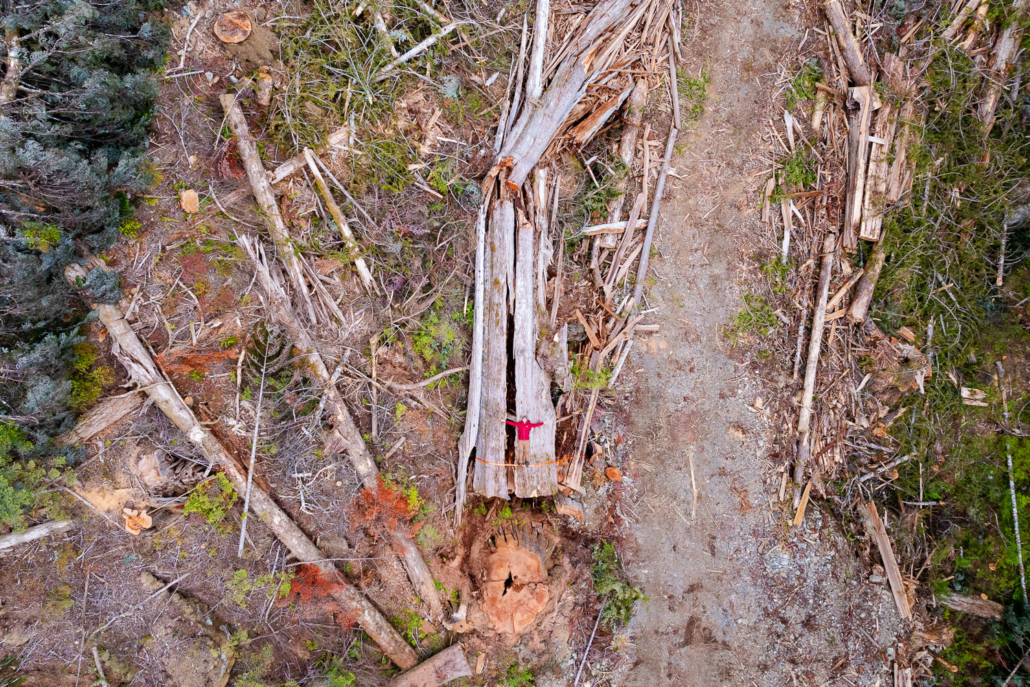
AFA photographer TJ Watt lays atop a giant fallen cedar for scale.
“When it comes to verifying forests for logging deferral, the Ministry of Forests is currently playing a game of old-growth subtraction in favour of the timber industry, facilitating more old-growth logging rather than less,” stated Watt. “As per their current policy, BC Timber Sales is actively using field verification to remove forests recommended for deferral that don’t meet the TAP criteria, but do not use the same practice to identify at-risk old-growth forests that may have been missed for deferral, such this one, so they have a chance at being added in and eventually protected. To help identify these at-risk stands, forest engineers should be legally bound to field-verify planned logging cutblocks against the TAP deferral criteria and report any discrepancies to the BC government so adjustments can be made. Citizens and scientists should also be able to submit the locations of key old-growth stands they’ve identified, which Forest Service foresters would then verify. Government data gaps and an approach that skews towards protecting the least amount of old-growth possible are leading to the loss of irreplaceable ancient forests vital to supporting endangered species, First Nations cultures, the climate, clean water, wild salmon, and tourism. Premier Eby should be instructing government staff to close this conservation loophole immediately.”
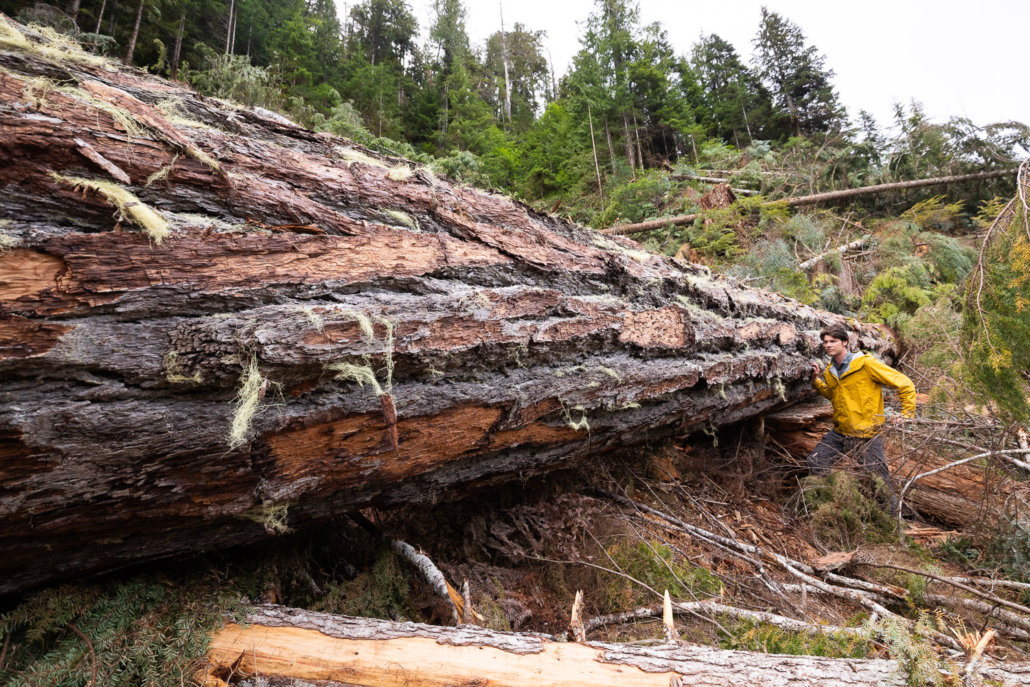
AFA researcher Ian Thomas beside the trunk of an old-growth Douglas-fir tree cut down in June 2024 in the Nahmint.
The Nahmint Valley has long been recognized as a place of exceptional ecological value. The province designated it a “high biodiversity emphasis” Special Management Zone to help protect its old-growth values and safeguard threatened ecosystems. Despite that legal requirement, successive governments have opened the Nahmint up to devastating logging practices, destroying some of the most magnificent forests on earth.
“The Nahmint is a Special Management Zone established to ensure old-growth values are maintained and biodiversity is safeguarded. And yet you see the liquidation of a threatened ecosystem home to countless species, including this rare old-growth dependent lichen species, observed possibly for the very first time in the Nahmint Valley, dying as it was discovered,” noted Ian Thomas, a researcher with the Ancient Forest Alliance. This forest was a rich, priceless ecosystem that is impossible to replace. It wasn’t a big multi-national corporation, but government staff who planned the logging of a forest that contained rare, big-tree old-growth and was home to at-risk species. All of this is in a landscape that is supposedly managed to protect biodiversity. Does the Ministry of Forests believe this is what putting ecosystem health before timber values looks like? If there were anywhere you might expect the promised ‘paradigm shift’ in forest management, it would be here in the Nahmint Valley.”
– See our information explaining the central importance of ecosystem-based targets and forest productivity distinctions.
– See our media release from May 2024 for a comprehensive list of the actions still needed from the BC government to protect old-growth forests and endangered ecosystems in BC.
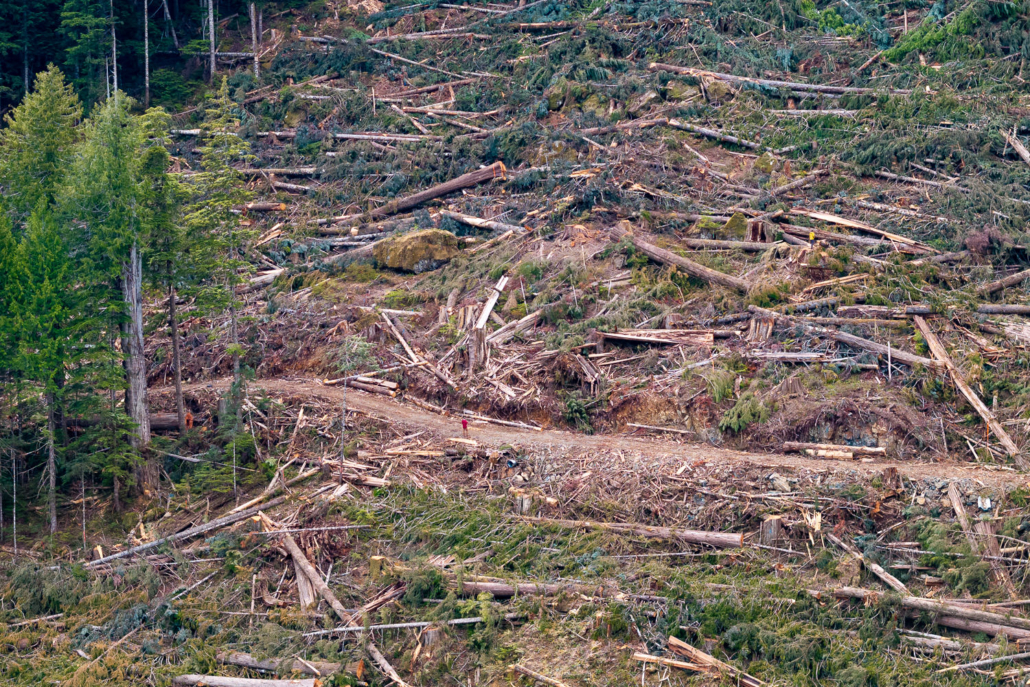
AFA’s TJ Watt (red) and Ian Thomas (yellow) provide scale to the scene of destruction.
Backgrounder
The Ancient Forest Alliance has fought for years to ensure greater protection for the old-growth forests in the Nahmint Valley. In 2018, the Ancient Forest Alliance exposed the logging of hundreds of hectares of spectacular ancient forests, including some of the largest trees in Canada. Ancient Forest Alliance filed a complaint with the independent BC Forest Practices Board, which found that the provincial government failed to adequately protect the exceptional ecological values of the Nahmint. In 2021, the resulting report from the independent Forest Practices Board found that the province was failing to adequately safeguard the ecological health of this Special Management Zone.
In 2022, the BC government released a draft landscape unit plan for the Nahmint Valley, placing some additional areas of old-growth forest into landscape reserves such as Old-Growth Management Areas. Though a welcome step, this planning was carried out under the previous paradigm where conservation could not significantly impact timber harvesting. As a result, the findings of the Technical Advisory Panel were not considered, and only about 30% of the productive forests were put into conservation reserves. Biologists agree that when ecosystems fall below 30% of their original extent, they are at high risk of irreversible biodiversity loss, and at least 70% of the original old-growth forests should be protected from logging to ensure long-term ecosystem health. In the Nahmint Valley, additional old-growth groves, including forests explicitly recommended for deferral by the Technical Advisory Panel that should have been protected in the draft landscape plan, are already planned for logging. Should BC Timber Sales’ future plans move forward, it will further fragment and destroy the old-growth forests of this remarkable valley.
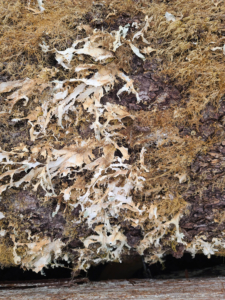
AFA has now documented what is likely the first known occurrence of old-growth specklebelly lichen in the Nahmint Valley (according to the page 21 summary list of known locations from 2015). Oldgrowth specklebelly lichen is federally and provincially listed as a species at risk, with only 52 known colonies in Canada. The highly sensitive lichen species depend on the humid microclimate of intact old-growth forests. The specimens observed were already dead or dying in the exposed clearcut. A photo of the lichen, which had lost much of its bluish colour after being in the sunlight, was sent to expert lichenologist Trevor Goward, who confirmed its presence. The provincial recovery plan for the species calls for the protection of each of these rare colonies from logging in order to “maintain all known extant populations and any future populations that may be found in British Columbia.” However, no formal legal protection exists.
Across BC, the BC NDP government has taken historic strides toward expanding the protection of old-growth forests and other endangered ecosystems across BC, such as securing over $1 billion in federal-provincial funding through the BC Nature Agreement, creating a $300 million conservation financing fund, committing to expanding protected areas in BC to 30% by 2030, drafting a Biodiversity and Ecosystem Health Framework still currently under development, and now undertaking discussions with dozens of First Nations on potential new Indigenous Protected and Conserved Areas (with several major protected areas recently announced, including ten new Conservancies in Clayoquot Sound and a 2000 square kilometer new Klinse-za/Twin Sisters Provincial Park in the far north). However, without dedicated “ecosystem-based” protection targets, in general, the most threatened and biodiverse ecosystems will continue to be largely excluded from new protected areas, which will focus on less-contested ecosystems at higher elevations and in the far North.
Old-growth forests support endangered species, First Nations cultures, the climate, clean water, wild salmon, and tourism. Under BC’s current system of forestry, second-growth tree plantations are typically re-logged every 50–60 years, never to become old-growth again.
